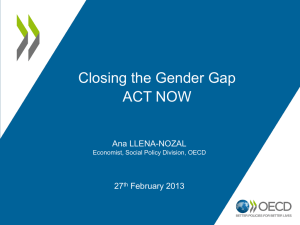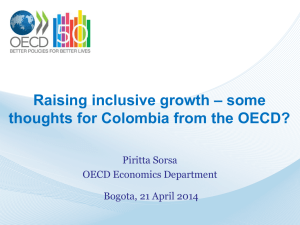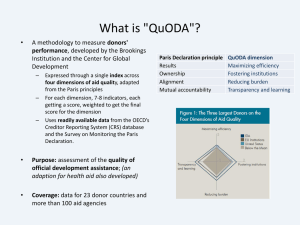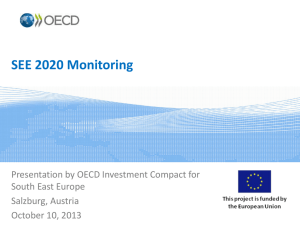Gender equality in Education, Employment and Entrepreneurship
advertisement
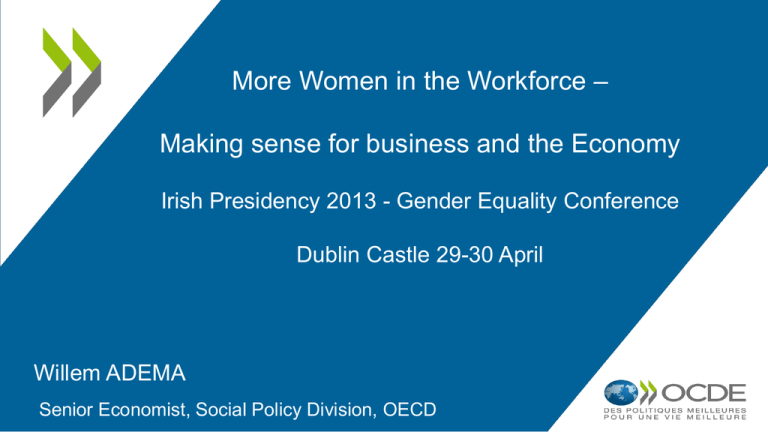
More Women in the Workforce – Making sense for business and the Economy Irish Presidency 2013 - Gender Equality Conference Dublin Castle 29-30 April Willem ADEMA Senior Economist, Social Policy Division, OECD Gender gaps in educational attainment have closed and/or reversed)in OECD countries but… Proportion of men and women who have a tertiary degree 2010, by age group 60 male 25-34 female 25-34 50 40 30 20 10 0 60 male 55-64 50 40 30 20 10 0 Source: OECD (2012), Education at a Glance female 55-64 ... despite gains in education, gender employment gaps continue to persist, also through the crisis. Employment rates by age group and gender, quarterly from 1st quarter 2007 to last quarter 2012 OECD – Working age pop. Men OECD - Young people Men 15-24 Women Source: OECD Gender Data Portal, www.oecd.org/gender/data Q3-2012 Q1-2012 Q3-2011 Q1-2011 Q3-2010 Q3-2012 Q1-2012 Q3-2011 Q1-2011 Q3-2010 Q1-2010 Q3-2009 Q1-2009 Q3-2008 Q1-2008 Q3-2007 Q1-2007 60 Q1-2010 65 Q3-2009 70 Q1-2009 75 Q3-2008 80 Q1-2008 85 Q3-2007 50 48 46 44 42 40 38 36 34 32 30 Q1-2007 90 Women 15-24 Women continue to have slower career progression … Women’s shares in the labour force and senior management in the private sector, 2010 % 60 Labour force share 50 40 30 20 10 0 Source: OECD (2012), Closing the Gender Gap, Act Now Senior manager share … be predominantly employed in certain economic service sectors… Feminisation rates of service activities % Transport, storage and communication 25 Public administration and defense 46 Other community activities, private household with employed persons 58 Education 70 Finance, intermediation, real estate, renting and business activities 45 Health and social work 78 Whole and retail trade, hotels and restaurants 50 0 Source: OECD (2012), Closing the Gender Gap, Act Now 20 40 60 80 100 … are less likely to be entrepreneurs... Employers as a proportion of the employed, by gender, 2010 % 12 Women 10 8 6 4 2 0 Source: OECD (2012), Closing the Gender Gap, Act Now Men … and have lower earnings. Gender pay gap in earnings for full-time employees, 2000 and 2010 2010 % 30 20 10 0 Source: OECD (2012), Closing the Gender Gap, Act Now 2000 Policy levers • Women are better educated and occupy more highly skilled, better paid jobs than before. It would be more efficient if economies and societies made better use of this through by: - Labour market institutions that allow swift adjustments of work patterns - Combined with family-friendly policies (e.g. childcare)… - Assessment and monitoring … while encouraging more equal gender sharing of paid and unpaid work (tax/ben policy, family policy) Men could do more at home Unpaid work and female employment rates, recent years Minutes of unpaid work per day 500 Female: R² = 0.43 400 TUR MEX PRT ITA POL 300 200 MEX TUR ZAF AUS IRL EST SVN NLDGBR NZL JPN ESP CAN FRA SWE AUT DEU BEL KOR NOR FIN CHN DNK USA DNK POL ESP EST SVN USA AUS FIN CAN SWE DEU NLD NOR BEL NZL GBR FRA AUT IRL HUN PRT CHN JPN KOR HUN ZAF 100 Male: R² = 0.21 ITA 0 20 30 40 50 60 Source: OECD (2012), Closing the Gender Gap Act Now. (www.oecd.org/gender) Source: OECD (2012), Closing the Gender Gap, Act Now 70 80 Women employment rate, % Provide paid employment-protected parental leave and promote more equal use among parents • Paid parental leave, Evidence suggests : – – • extending parental leave entitlements had a small positive effect on the female-to-male employment ratio but only up to two years of leave; extending paid parental leave is associated with an increase in the gender pay gap among full-time workers; Encourage fathers to take available parental leave, also by reserving part of the parental leave entitlement for their exclusive and nontransferable use. Source: OECD (2012), Closing the Gender Gap, Act Now Paid parental leave (supplementary to paid maternity leave), 2008 Gender pay gap age 30-34 % 30 R² = 0.604 SVK AUT JPN 25 CZE 20 15 FIN CAN KOR DEU USA AUS DNK NOR GBR IRL 10 BEL 5 NZL 0 0 50 100 150 Number of paid weeks of parental leave 200 Closing the gaps in participation can help sustain labour force and gdp growth No change scenario Convergence in participation rates Convergence in intensity of labour market participation 42 000 United Kingdom 38 000 34 000 30 000 47 000 Germany 43 000 39 000 35 000 Source: OECD (2012), Closing the Gender Gap, Act Now THANK YOU and FURTHER READING! www.oecd.org/gender
